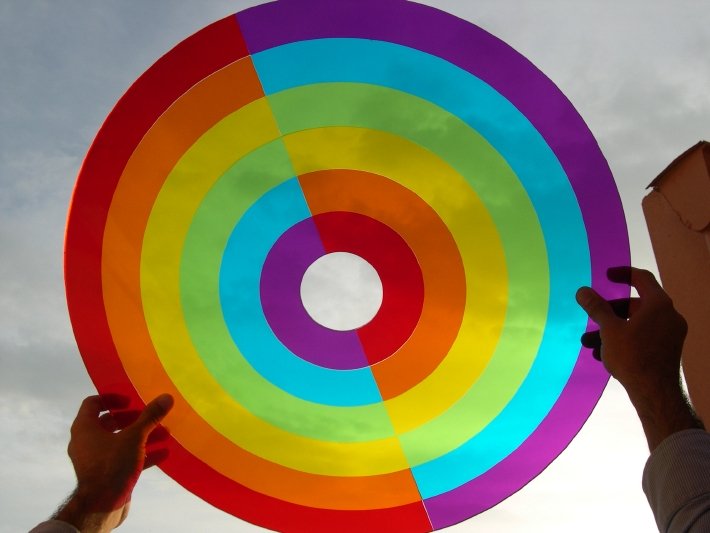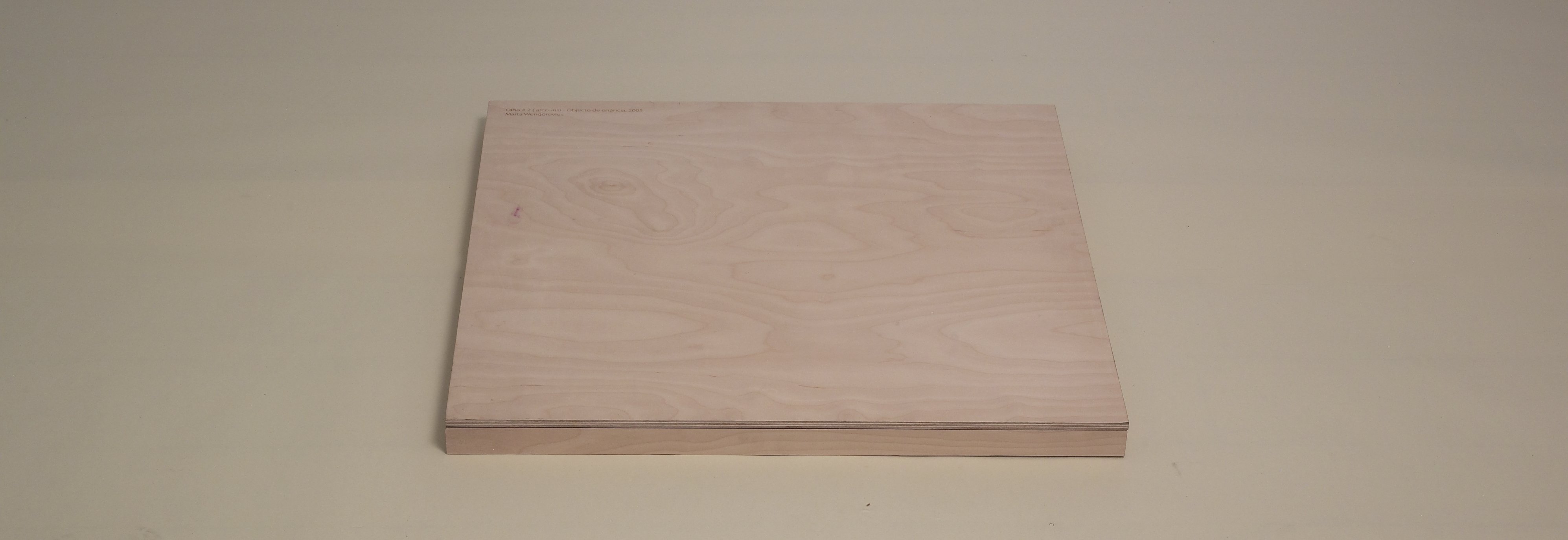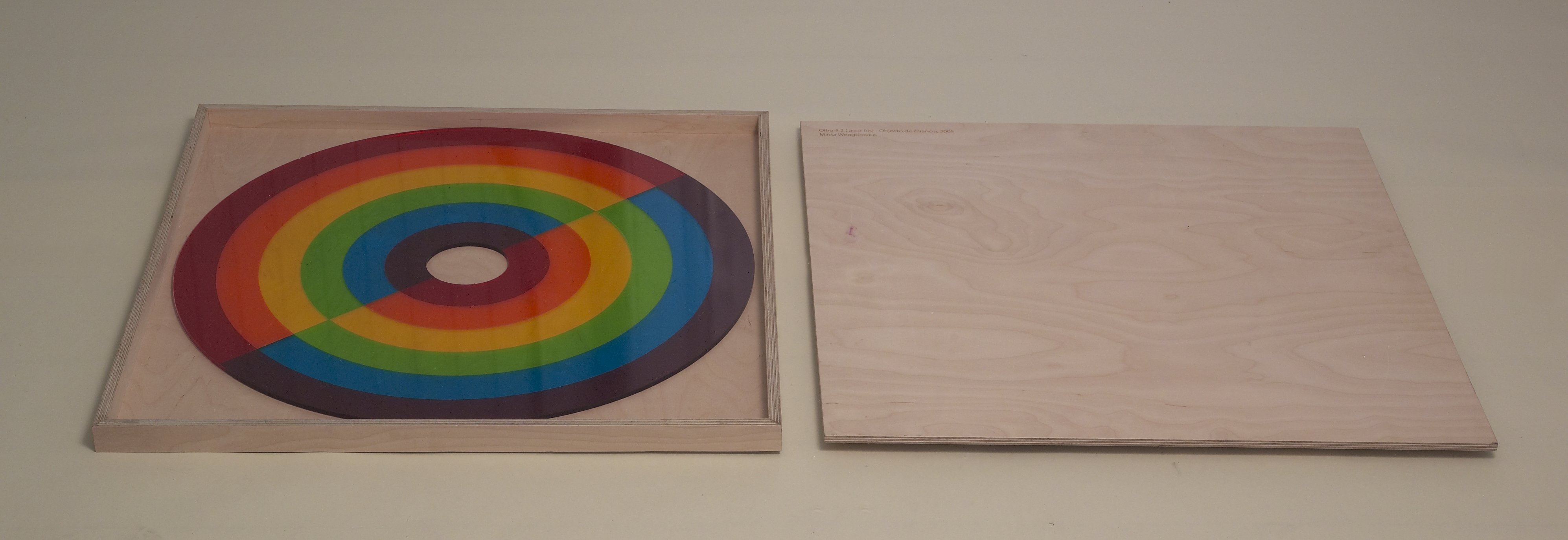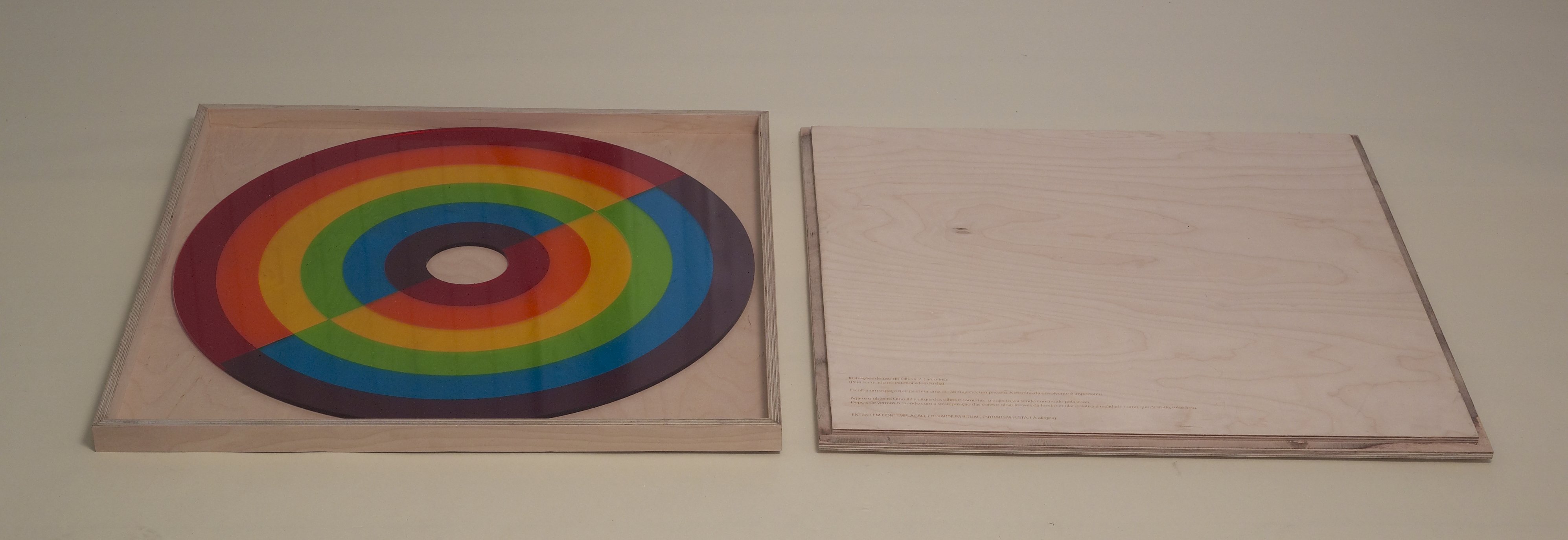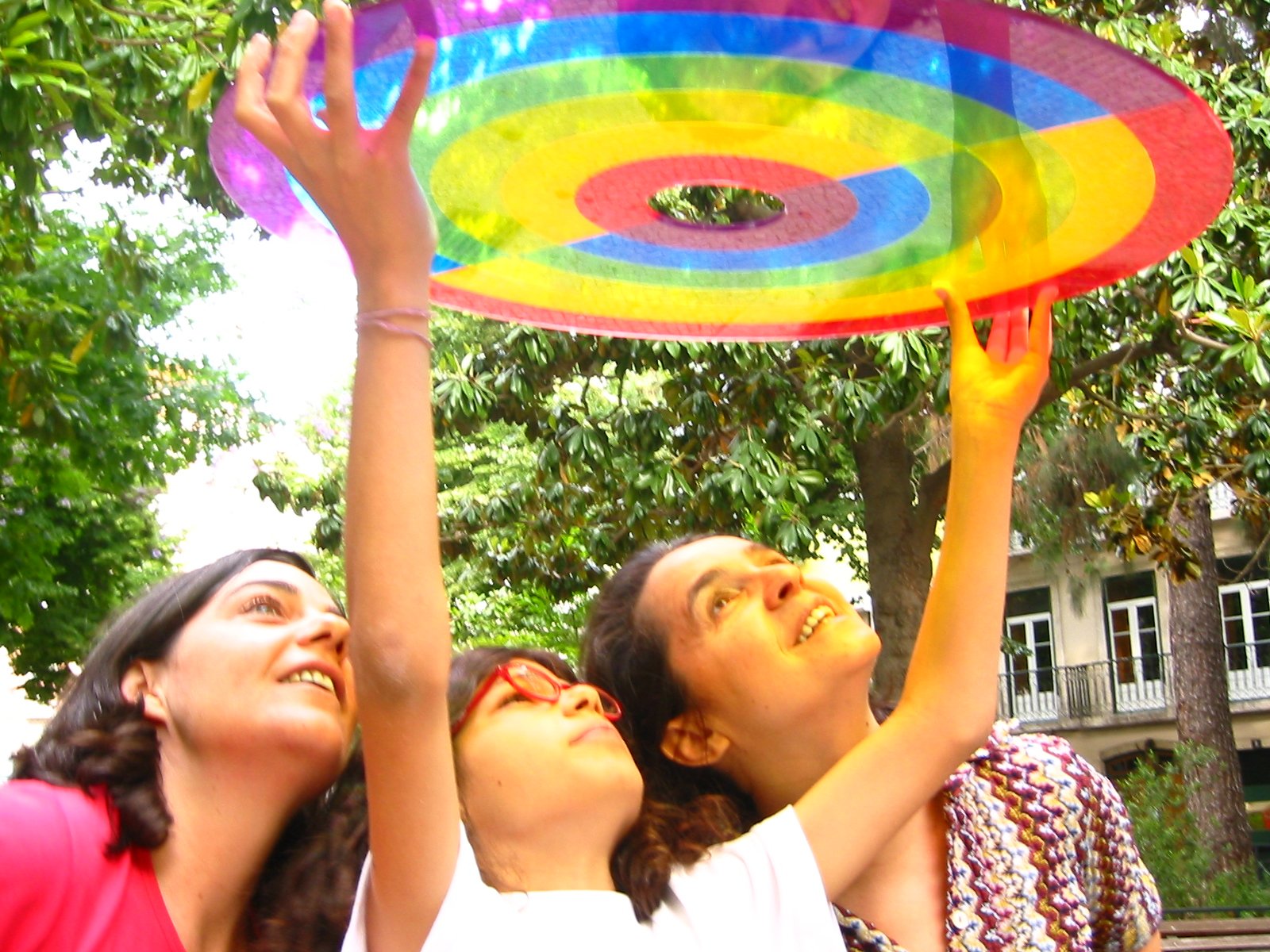Acrílico transparente e doze películas de seis cores em vinil
Ø 60 cm e 8,5 cm, espessura 0,5cm
1/3 Museu de Arte Contemporânea de Elvas
Instruções para uso do Olho #2 (arco-íris) :
É um objecto perfomático para um uso pontual. Este no seu uso sugere um percurso um caminhar e ver através, o que está em redor, nesse sentido é um objecto de rua. Pode levá-lo consigo e sair do museu. E reparar como este objecto faz uma ponte com o céu e tudo que nele habita (como o próprio arco-iris). Repara-se que depois da experiência de ver o mundo através das cores ao vermos a realidade pelo vazio do objecto esta parece como que despida.
Olho #2 tem duas versões de diferentes dimensões. Uma das versões, foi expressamente concebida para o projecto Quinta essência (instituição que se ocupa de crianças e adolescentes com deficiências mentais). Por esta razão alarguei o diâmetro para 100 cm e o vazio proporcionalmente. É um objecto para ser agarrado pelas duas mãos e ser colocado à altura dos olhos de quem o transporta. É um objecto-acção. É um objecto de visão, não no sentido de um objecto que apela a ser olhado em si, mas através de si, atravessado. E tal como Olho #1 presta-se a ser utilizado em acção registada em filme ou fotografia, memória dessa performance. É um objecto para ser colocado diante dos olhos e para ver através. Mas não se reduz à experiência daquele que o usa porque se alarga também a quem vê aquele que vê através do objecto. As dimensões do círculo propiciam uma experiência, algo espectacular pois o sujeito usufruidor e a envolvente reflectem a forma e a cor do objecto, alargando fisicamente as dimensões físicas da própria obra.
Para o sujeito que vê através abrem-se diferentes possibilidades de visão: ver através dos arcos de cor – 6 cores – aproximando-o ou afastando-o; ver através do círculo central vazio; ou ainda, se quisermos, na linha definida pela junção das cores. Deste horizonte de possibilidades nasce o movimento específico desta obra: procurar o que ver, escolher o que ver, ser écran de luz e cor, que cor ver ou o que ver através da ausência de filtro através do vazio central. Terá razão Ernst Cassirer, quando afirma que o homem já não pode defrontar a realidade face a face; não pode vê-la, por assim dizer, face a face?.
E colocamos esta questão porque depois da experiência de ver o mundo através das cores que lhe sobrepomos, a realidade aparece como que despida, numa nudez original. Para que esse processo aconteça é necessária uma deslocação entre cor e ausência de cor, entre ver através das cores e através do vazio.
O trajecto é construído pela visão. O contexto é proposto pela artista: a escolha da paisagem onde esta convida ao uso do olho. Proposta a paisagem o trajecto é livre. Cada usufrutuário consolida a sua experiência visual dando corpo a um quadro ao escolher o campo visual, as intensidades de cor, ao registar a pintura em si, criando através do uso da obra a obra e re-criando-a em simultâneo. Cada si – reflexivo – incorpora uma diferente memória da pintura vivenciada, registando sensorialmente o si em acção, mas não a sua imagem em acção, porque ninguém se vê a si próprio. Importa também o lado performativo do objecto em questão: quem observa quem? O que se pretende com quem assiste? Que se observe um caminhar?
Quem caminha faz parte da obra e está a fazer obra ao caminhar. A obra é um eu, um círculo translúcido e o universo. Ela não é retiniana-em-si mas convida assumidamente a uma experiência em que o motor são os olhos. Ela é ainda retiniana enquanto o que conduz o sujeito da acção são os olhos. Também não tem as características de Bichos de Lígia Clark, no sentido de objectos de manipulação em que o jogo é a manipulação de um corpo-objecto-quase-vivo articulável mas fechado em si.
O olhar no caso de Bichos é orientado para dentro das peças e da acção que sobre elas se faz. Atraído para dentro de um corpo, que mais tarde será não o de Bichos mas o da artista. Mas, esta obra também não tem as características do olhar em feedback das obras especulares de Pistoletto. Porque na janela – quadro especular de Pistoletto esta reflecte e emite tudo o que é reflectido. No Olho o olhar atravessa o objecto, ultrapassa a janela, convida a um todo (eu-obra-mundo). É uma das formas de criar vocabulário no mundo, a de partilhar experiências visuais. Ou a da partilha dessa cumplicidade:um dia deixei de ir à missa. O sol estava a nascer, e era tão bonito! E eu disse à pessoa que estava comigo: Fico aqui a ver o sol. E ela compreendeu. Fiquei-lhe sempre grata.
No entanto existe sempre o objecto. O objecto que está guardado na caixa quando não está em performance. É este estar só, no seu descanso outro acontecimento?
Dupla existência, múltipla existência. Mas para que este objecto ganhe total sentido é preciso lembrar Malevich O nada de um mundo sem objecto é o ser. Este objecto exige também o esquecimento de ser-objecto, a Terra como lhe chamava Heidegger, para que por ele se possa abrir um Mundo.
Ø 60 cm e 8,5 cm, thick 0,5cm
Acrylic and vinyl
1/3 Museum of Contemporary Art of Elvas
Instructions for use (to be used outdoors in daylight):
Choose a space where it is possible to perform a trajectory-action, a stroll. The choice of the surroundings is important.
Hold the object Eye #2 at eye level and walk: as you move your vision creates the trajectory.
After having seen the world with the superimposed colours, the gaze through the circular opening emphasises the bareness of reality, mise à nu.
Varied dimensions in use. Olho #2 (Eye #2) has two different versions. One of them was explicitly conceived for the project Quinta essência (institution dedicated to handicapped children and adolescents). For this reason, I have enlarged it to a diameter of 100 cm and the void hole proportionally. Olho #2 (Eye #2) is an object to be grabbed by the two hands and put at the carrier’s eye level. It is an object-action. It is an object of vision, not in the sense of an object that calls to be looked at by itself, but through it, crossed. And, as Olho #1(Eye #1), it is to be used in an action, registered in film or photographs, memory of that performance.
It is an object to be set in front of one’s eyes and to look through. But it does not resume itself to the experience of the one who sees through the object. The dimensions promote an experience, something spectacular, because the one who acts and the surroundings reflect the object’s form and colour, enlarging physically the physical dimensions of the work itself. For the participant who sees through it, different seeing possibilities emerge: to watch the colour’s arches – 6 colours – moving in closer or further away; to see through the empty central void; or, still, if we want, to the line defined by the colour’s union. From this horizon of possibilities is born this work’s intrinsic movement: to search for what to look at, choose what to look at; to be the light and colour’s screen; which colour to observe; or look at the absence of filter through the central void. Can Ernst Cassirer be right when he asserts man can no longer confront reality faceto – face; he cannot see it, so to speak, face-to-face?.
And we raise this question because after the experience of seeing the world through the superimposed colours, reality appears naked, of an primordial nudity. For this process to take place, the displacement between colour and absence of colour, between seeing through the colours and through the void, is needed. The trajectory is constructed by vision. The context is proposed by the artist: the landscape’s choice where she invites for the use of the eye.
The landscape is proposed, the trajectory is free. Each user consolidates the visual experience by bringing into being a frame during the choice of a visual champ, the colour’s intensity, and registering the painting itself, creating, by the use of the work, the work itself, and recreating it simultaneously. Each reflective self incorporates a different memory of the experienced painting, registering sensorially the self in action, but not oneself in action, because no-one sees one’s self in action.
It is also of interest the performative side of the object in question: Who watches who? What is intended by those observing the user? The observation of a path? The one who walks is an integral part of the work, and is doing a work while walking. The work is an I, a translucid circle and the universe. The work is not retinal in itself, but it expressly invites to an experience in which the motor are the eyes. As long as what conduces the agent into action are the eyes, it still is retinal.
It also does not have the characteristics of Lígia Clark’s Bichos, in the sense of objects of manipulation where the game is the manipulation of a body-objectalmost-alive, articulable but closed in itself. Bichos’ sight is directed to the pieces and to the action done upon them. Attracted into a body’s interior, which subsequently will be the artist’s body, instead of the Bichos’ body. But, this work also does not have the regard’s characteristics in Pistoletto’s specular works.
Because Pistoletto’s window – specular painting reflects and emits everything that is reflected. In Olho (Eye), the regard crosses the object, it goes beyond the window, it invites a wholeness (self-work-world). It is a way of creating vocabulary in a world, of sharing visual experiences. Or about the sharing of that complicity: “one day I stop going to mess. The sun was rising, and it was so beautiful! And I said to the person who was with me: I’ll stay here watching the sun. And she understood. I was forever grateful.” However, there is always the object. The object that is stored in a box when it is not performing. Is this being alone, in its rest, another happening? Double existence, multiple existence. But for this object to gain a complete meaning, It is necessary to remember Malevich The nothingness of a world without object is the being. This object also demands the oblivion of being-object, the earth, as Heidegger called it, for a world to open though it.
- + PT
-
Acrílico transparente e doze películas de seis cores em vinil
Ø 60 cm e 8,5 cm, espessura 0,5cm1/3 Museu de Arte Contemporânea de Elvas
Instruções para uso do Olho #2 (arco-íris) :
É um objecto perfomático para um uso pontual. Este no seu uso sugere um percurso um caminhar e ver através, o que está em redor, nesse sentido é um objecto de rua. Pode levá-lo consigo e sair do museu. E reparar como este objecto faz uma ponte com o céu e tudo que nele habita (como o próprio arco-iris). Repara-se que depois da experiência de ver o mundo através das cores ao vermos a realidade pelo vazio do objecto esta parece como que despida.
Olho #2 tem duas versões de diferentes dimensões. Uma das versões, foi expressamente concebida para o projecto Quinta essência (instituição que se ocupa de crianças e adolescentes com deficiências mentais). Por esta razão alarguei o diâmetro para 100 cm e o vazio proporcionalmente. É um objecto para ser agarrado pelas duas mãos e ser colocado à altura dos olhos de quem o transporta. É um objecto-acção. É um objecto de visão, não no sentido de um objecto que apela a ser olhado em si, mas através de si, atravessado. E tal como Olho #1 presta-se a ser utilizado em acção registada em filme ou fotografia, memória dessa performance. É um objecto para ser colocado diante dos olhos e para ver através. Mas não se reduz à experiência daquele que o usa porque se alarga também a quem vê aquele que vê através do objecto. As dimensões do círculo propiciam uma experiência, algo espectacular pois o sujeito usufruidor e a envolvente reflectem a forma e a cor do objecto, alargando fisicamente as dimensões físicas da própria obra.
Para o sujeito que vê através abrem-se diferentes possibilidades de visão: ver através dos arcos de cor – 6 cores – aproximando-o ou afastando-o; ver através do círculo central vazio; ou ainda, se quisermos, na linha definida pela junção das cores. Deste horizonte de possibilidades nasce o movimento específico desta obra: procurar o que ver, escolher o que ver, ser écran de luz e cor, que cor ver ou o que ver através da ausência de filtro através do vazio central. Terá razão Ernst Cassirer, quando afirma que o homem já não pode defrontar a realidade face a face; não pode vê-la, por assim dizer, face a face?.
E colocamos esta questão porque depois da experiência de ver o mundo através das cores que lhe sobrepomos, a realidade aparece como que despida, numa nudez original. Para que esse processo aconteça é necessária uma deslocação entre cor e ausência de cor, entre ver através das cores e através do vazio.
O trajecto é construído pela visão. O contexto é proposto pela artista: a escolha da paisagem onde esta convida ao uso do olho. Proposta a paisagem o trajecto é livre. Cada usufrutuário consolida a sua experiência visual dando corpo a um quadro ao escolher o campo visual, as intensidades de cor, ao registar a pintura em si, criando através do uso da obra a obra e re-criando-a em simultâneo. Cada si – reflexivo – incorpora uma diferente memória da pintura vivenciada, registando sensorialmente o si em acção, mas não a sua imagem em acção, porque ninguém se vê a si próprio. Importa também o lado performativo do objecto em questão: quem observa quem? O que se pretende com quem assiste? Que se observe um caminhar?
Quem caminha faz parte da obra e está a fazer obra ao caminhar. A obra é um eu, um círculo translúcido e o universo. Ela não é retiniana-em-si mas convida assumidamente a uma experiência em que o motor são os olhos. Ela é ainda retiniana enquanto o que conduz o sujeito da acção são os olhos. Também não tem as características de Bichos de Lígia Clark, no sentido de objectos de manipulação em que o jogo é a manipulação de um corpo-objecto-quase-vivo articulável mas fechado em si.
O olhar no caso de Bichos é orientado para dentro das peças e da acção que sobre elas se faz. Atraído para dentro de um corpo, que mais tarde será não o de Bichos mas o da artista. Mas, esta obra também não tem as características do olhar em feedback das obras especulares de Pistoletto. Porque na janela – quadro especular de Pistoletto esta reflecte e emite tudo o que é reflectido. No Olho o olhar atravessa o objecto, ultrapassa a janela, convida a um todo (eu-obra-mundo). É uma das formas de criar vocabulário no mundo, a de partilhar experiências visuais. Ou a da partilha dessa cumplicidade:um dia deixei de ir à missa. O sol estava a nascer, e era tão bonito! E eu disse à pessoa que estava comigo: Fico aqui a ver o sol. E ela compreendeu. Fiquei-lhe sempre grata.
No entanto existe sempre o objecto. O objecto que está guardado na caixa quando não está em performance. É este estar só, no seu descanso outro acontecimento?
Dupla existência, múltipla existência. Mas para que este objecto ganhe total sentido é preciso lembrar Malevich O nada de um mundo sem objecto é o ser. Este objecto exige também o esquecimento de ser-objecto, a Terra como lhe chamava Heidegger, para que por ele se possa abrir um Mundo.
- + EN
-
Ø 60 cm e 8,5 cm, thick 0,5cm
Acrylic and vinyl1/3 Museum of Contemporary Art of Elvas
Instructions for use (to be used outdoors in daylight):
Choose a space where it is possible to perform a trajectory-action, a stroll. The choice of the surroundings is important.
Hold the object Eye #2 at eye level and walk: as you move your vision creates the trajectory.
After having seen the world with the superimposed colours, the gaze through the circular opening emphasises the bareness of reality, mise à nu.
Varied dimensions in use. Olho #2 (Eye #2) has two different versions. One of them was explicitly conceived for the project Quinta essência (institution dedicated to handicapped children and adolescents). For this reason, I have enlarged it to a diameter of 100 cm and the void hole proportionally. Olho #2 (Eye #2) is an object to be grabbed by the two hands and put at the carrier’s eye level. It is an object-action. It is an object of vision, not in the sense of an object that calls to be looked at by itself, but through it, crossed. And, as Olho #1(Eye #1), it is to be used in an action, registered in film or photographs, memory of that performance.
It is an object to be set in front of one’s eyes and to look through. But it does not resume itself to the experience of the one who sees through the object. The dimensions promote an experience, something spectacular, because the one who acts and the surroundings reflect the object’s form and colour, enlarging physically the physical dimensions of the work itself. For the participant who sees through it, different seeing possibilities emerge: to watch the colour’s arches – 6 colours – moving in closer or further away; to see through the empty central void; or, still, if we want, to the line defined by the colour’s union. From this horizon of possibilities is born this work’s intrinsic movement: to search for what to look at, choose what to look at; to be the light and colour’s screen; which colour to observe; or look at the absence of filter through the central void. Can Ernst Cassirer be right when he asserts man can no longer confront reality faceto – face; he cannot see it, so to speak, face-to-face?.
And we raise this question because after the experience of seeing the world through the superimposed colours, reality appears naked, of an primordial nudity. For this process to take place, the displacement between colour and absence of colour, between seeing through the colours and through the void, is needed. The trajectory is constructed by vision. The context is proposed by the artist: the landscape’s choice where she invites for the use of the eye.
The landscape is proposed, the trajectory is free. Each user consolidates the visual experience by bringing into being a frame during the choice of a visual champ, the colour’s intensity, and registering the painting itself, creating, by the use of the work, the work itself, and recreating it simultaneously. Each reflective self incorporates a different memory of the experienced painting, registering sensorially the self in action, but not oneself in action, because no-one sees one’s self in action.
It is also of interest the performative side of the object in question: Who watches who? What is intended by those observing the user? The observation of a path? The one who walks is an integral part of the work, and is doing a work while walking. The work is an I, a translucid circle and the universe. The work is not retinal in itself, but it expressly invites to an experience in which the motor are the eyes. As long as what conduces the agent into action are the eyes, it still is retinal.
It also does not have the characteristics of Lígia Clark’s Bichos, in the sense of objects of manipulation where the game is the manipulation of a body-objectalmost-alive, articulable but closed in itself. Bichos’ sight is directed to the pieces and to the action done upon them. Attracted into a body’s interior, which subsequently will be the artist’s body, instead of the Bichos’ body. But, this work also does not have the regard’s characteristics in Pistoletto’s specular works.
Because Pistoletto’s window – specular painting reflects and emits everything that is reflected. In Olho (Eye), the regard crosses the object, it goes beyond the window, it invites a wholeness (self-work-world). It is a way of creating vocabulary in a world, of sharing visual experiences. Or about the sharing of that complicity: “one day I stop going to mess. The sun was rising, and it was so beautiful! And I said to the person who was with me: I’ll stay here watching the sun. And she understood. I was forever grateful.” However, there is always the object. The object that is stored in a box when it is not performing. Is this being alone, in its rest, another happening? Double existence, multiple existence. But for this object to gain a complete meaning, It is necessary to remember Malevich The nothingness of a world without object is the being. This object also demands the oblivion of being-object, the earth, as Heidegger called it, for a world to open though it.

